|
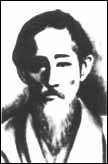 KANRYO HIGAONNA
KANRYO HIGAONNA
Higaonna was born in 1853, in
Okinawa. He was small, but his skill and hard training more than made up for
his deficiency in size. He started the serious study of the martial arts
when he was about sixteen years old. He learned Chinese Kempo and became
well known in Naha. He was fascinated by the Chinese fighting arts and began
looking for an opportunity to travel to China. In November of 1874, he
finally had the chance to go to China with a group of merchants. He left
Okinawa and spent fifteen years in China. When he finally returned to
Okinawa, he was thirty-seven years old. In spite of his many years of
training in the Chinese martial arts, he did not want to teach upon his
return. Even after he was convinced to open a dojo by those people who had
heard of his reputation in China, he would teach his martial arts only to
the most serious students. He taught martial arts in the most traditional
manner to those who would learn, not to those who wanted to be taught. Thus
Higaonna was credited with bringing martial arts to Okinawa. Many would be
students came to Higaonna and many more were sent on their way. However, one
boy by the name of Chojun Miyagi did not only stay but was eventually to
succeed his teacher and became the founder of Goyu-Ryu in Karate.
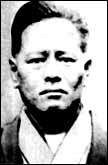 CHOJUN
MIYAGI CHOJUN
MIYAGI
Chojun Miyagi was born in 1888, in
Naha, Okinawa. When he was fourteen years old he started to study Karate
with Grandmaster Higaonna. Through his dedication to the study of the
martial arts, Miyagi was credited with making the system solid and well
respected. He was such a dominant force in modern Karate that he became well
known not only as the founder of Goju-Ryu Karate but also as the true leader
of Okinawas and Japanese Karate. This is why the roots of modern Karate are
traced back to this man. Master Chojun first came to Japan in 1928, and
instructed at the Kyoto University in Kyoto. In 1932, he became an
instructor in the Kansaugakuen in Osaka, thirty miles from Kyoto. By 1937,
Karate was fully accepted by the Japanese public, yet the study of it was
isolated to military basses and a handful of universities.
Dec.
1927: Had a seminar with the founder of Judo, Dr. Jigoro Kano
Apr.
1929: Became Shihan of Okinawan Police. Became Shihan of Naha School of
Commerce.
Nov.
1930: Okinawan Athletic Association accepted Karate as part of its
curriculum.
1927-1930:
Taught at Japan Kansai University, Osaka; Ritsumei University,
Kyoto;Doshisha University, Kyoto.
Apr.
1934: Visited Hawaii.
May
1937: Received first doctorate degree in Karate.
Apr.
1953: Became Shihan of Okinawa Shihan (teachers) School.
Oct. 1953: Died at the age of 65
years.
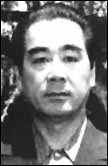 SEIGO TADA
SEIGO TADA
In 1922, Tada was born in Kyoto
where Karate was very popular. He started training in the art of Karate in
Shanghai, China in 1935, at the age of thirteen. In 1939, he entered the
Ritsusmei University and studied Goju-Ryu Karate-Do under the master and
founder of the style, Mr. Chojun Maiygi. He entered Ritsumei University nine
years after Yamaguchi started the Karate club in Ritsumei-Kan. He opened a
Karate dojo in Kyoto in 1945, right after World War II which is also when
Yamaguchi returned from Manchu. Tada continued to enjoy teaching Karate and
was able to see the 40th anniversary of his Seigo-Kan Karate Academy before
his eventual death in late September of 1997. His legacy, Seigo-Kan remains
the largest Goju-Ryu organization in Japan.
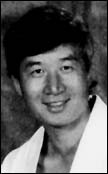 MOTOO YAMAKURA
MOTOO YAMAKURA
Motoo Yamakura was born in Kyoto,
Japan in 1943. His father was an educator and an officer in the Japanese
Imperial Army and led the Eighth Battalion in World War I. After the war,
the elder Yamakura spent most of his time teaching math and Japanese
writings. In addition, he was an expert in Kendo.
Motoo Yamakura was wild and violent
in his youth. He was the type of child who was always getting into trouble.
At the age of 8, he was renowned in his neighborhood as the best fighter in
his age group. He was often involved in fights with older boys and was
beaten up many times.
At this time he started his formal
Karate training. He studied in the Temple of Kyoto where many Karate schools
were to be found. The basic moves of Karate were taught there, but students
also spent much of their time practicing kobudo (weapons) in the temple's
yard. Classes were held only at night. Running through the nearby mountains
was one of the major forms of training. His involvement in neighborhood
fights continued, and Yamakura was not completely satisfied with the
teaching in the temple because it taught more theories and discipline than
fighting skills.
Located a few miles from where
Yamakura lived was one of the branches of Tada's organization, the Tojukuji
Dojo, which was known to be a tough school. Mr. Sakata, then a yon-dan, was
the dojo instructor. Yamakura had visited there previously but had decided
not to attend because the students looked too tough and there were no
children in the dojo. This time, however, he was older and more desperate,
and he thought the training available in Tojukuji Dojo would make him
tougher. In this dojo, at the age of 14, Yamakura was much too young and too
small to be the king of the hill. He now lost more fights than he won. He
was anything but a star in his new dojo. There were no junior divisions,
even though junior rankings were accepted as token signs of progress. The
only real distinctions of rank were either black belt or white belt, though
there were also a few brown belts.
Full contact was permitted in the
matches. Yamakura would never forget those gloomy days in the dojo training.
A bloody nose was a daily routine, and a broken tooth was not uncommon. Only
the toughest survived th rigorous training. The training fee was so nominal
that financial burden was not a factor in entering or quitting. Training
started with beginners mopping the hardwood floor, a task that Yamskura
spent many hours on than did his peers. Next on the training schedule was
kihon led by instructors who were appointed daily by the instructor (Shi Han
Dai).
Kihon was the longest part of the
training. All the students spent half of their time practicing kihons,
including body shifting exercise. pre-arranged sparring was then taught and
practiced. Katas were practiced and evaluated but were never given much time
during the training period.
A more regimented training would
come to Yamakura's karate life when he was to enter his college karate club.
But for the present, body strengthening exercises were optional. Yamakura
spent many hours of kata training before the start of class. Running,
makiwara and nigiri-game were also optional and could stretch a normal two-hour
training session into four or more hours.
Everyone wanted to learn, yet no one
wanted to suffer, but there was no way around the suffering. Senior
instructors started beginners with nice and easy training, but as the
students began to progress, the delivery of a "lesson" became a very common
occurrence. A "lesson" taught a student not to be overconfident. Training
became like an obstacle course. Yamakura would overcome one obstacle and
become comfortable with training, and then another obstacle would be thrown
at him.
In the beginning instructors threw
punches and kicks slowly so that the beginners could block. But later, more
than once, those attacks became forceful. Instructors' punches landing in
faces and kicks driving into stomachs became a common scene in the dojo. The
sounds of groaning and moaning were often heard. Needless to say, Yamakura's
early stage of karate training was not a glorious one.
Yamakura remembers the famous
training method which strengthened him tremendously. "I was hit on the nose
and the blood was all over my face. I was on the floor in the corner of the
dojo. I was given a cold towel to put on my face while the instructor tapped
on the back of my neck to stop the bleeding. A few minutes later, when the
flow of blood had stopped, I was back on the floor facing the same person
who had just hit me. he told me `Yamakura, it is dishonor to be hit on the
same spot by the same person - cover your nose.' I put both hands in front
of my face. He then threw a hard punch which hit my hands and drove them
into my face which resulted in my landing on the floor again."
The instructor then said, "Remember,
you cannot block punches by simply placing your hands in front of your face.
Blocking is the art of catching a flying object in mid-air. Block punches
and kicks with your eyes, move your body accordingly, go with the flow of
the fight, catch the attack at the right moment. That is why the Okinawans
practice by using tropical fruit." This comes from the well known story that
one of the training methods used in Okinawa is to have someone throw adanin,
a tropical fruit, at you while you try to dodge, evade or catch the thrown
fruit. Suddenly, Yamakura recalled when and realized why he had been made to
practice Karate in the dark in the temple.
Yamakura's motto in Karate training
became, "Train your stomach to be so strong that you can take punches and
kicks without damage". This training must start with regular sit-ups and
progress to Sanchin practice. Learn the laws of breathing and combine them
with the flexing and relaxation of muscles. Do not make your stomach muscles
rigid like steel, but make them firm like a rubber ball. Do not attempt to
bounce the attacker's punches and kicks off your stomach. If you do, you
will need to generate the same amount of force as the attack. Less force
will be needed if you absorb the attack with the stomach muscles. Yamakura
learned the secret of this stomach training and became famous for it.
In 1965, Yamakura participated in
the annual Seigo Academy tournament. In the grand championship free style
sparring match, Yamakura was matched with a senior instructor. Yamakura was
the winner of the university division, and his senior was the winner of the
general division which included all dojo students, military clubs, and also
the graduates from the university clubs. This division obviously was
considered to be much stronger than the university division.
During the opening moments of the
match, the senior landed one of the fierce front snaps for which he was
famous. This tremendous kick caught Yamakura full in the stomach, landing so
powerfully that all in the arena could hear the loud sound of impact.
Everyone thought that Yamakura was hurt and worried about his ability to
continue. This, however, was not the case. Yamakura simply smiled
confidently and continued the match. There had been no damage to either his
body or his fighting spirit. Even though the baffled senior instructor had
scored the first point with that tremendous kick, Yamakura went on to win
the match.
Master Tada was walking down a
hallway far from the fighting arena when he heard the thunderous noise of
the senior's kick and asked a judge walking with him what had happened. The
judge went back to the tournament arena and then returned, reporting to
Master Tada that the senior instructor's front kick had scored. Master Tada
then asked who it was that had received the mighty kick. When the judge
reported that it was Yamakura, Master Tada continued walking to his office
saying, "Then it will be no problem".
KARATE TOURNAMENTS
Yamakura entered all Western Goju
Ryu Seigo Kan tournaments and he was champion in both kata and kumite in
1965 and 1966. In 1967, only 30 days after his arrival in Boston, Yamakura
entered his first American Karate tournament. The tournament was the
prestigious Henry Cho's All American held in Madison Square Garden, New York.
Yamakura won the light weight championship. After one final good will
tournament in Muskegon, Michigan, he retired from competition.
HIS U.S. MILITARY EXPERIENCE
Yamakura came to the United States
in April 1967. He was accepted for permanent residency in December 1968.
There was no precedent in the immigration codes for his field of expertise
so, with the help of an attorney, a new category was created. Yamakura was
one of the first people, if not the first, to receive permanent residency
status in the specially skilled labor category of Combat Fighting Specialist.
This was a troubled time for the
United States. The country was at the peak of the fighting in the Vietnam
War. Since Yamakura was at the top of the 1969 draft, he enlisted in the
Massachusetts National Guard. Even though there were approximately 2,000
people on the waiting list, Yamakura was called up within a week because of
his special skills. He was immediately assigned to report for basic
training. He was assigned to Fort Jackson, South Carolina, for basic
training. He was assigned to the Special Forces where he spent most of his
time teaching hand-to-hand combat. He demonstrated his martial arts skills
for trainees at war games, battalion gatherings, graduations and for the
Green Berets. he even gave a demonstration at his own graduation which was
attended by the Undersecretary of State.
During his military career, Yamakura
trained thousands of soldiers at company, battalion. and even post levels.
He was well known in South Carolina, and many drill instructors from North
Carolina and Georgia sought his instruction. He became well-known and well-liked
in the military. He ended his military obligation as a Staff Sergeant in
1974.
HIS MARTIAL ARTS PREFERENCE
Yamakura wants to be an
international person. He was born in Japan but traveled to the United States
and became an American Citizen. He studied English literature while in Japan.
He graduated from the foreign studies department where he also learned
Spanish and studied Chinese as it relates to Japanese characters. He studied
kobudo in his youth, judo in his school days, and has studied karate for
over thirty-five years. While in Japan, he studied the styles of Shotokan,
Shito-Ryu, and Wado-Ryu as well as Goju-Ryu. He also practiced Sholinji-Kempo
with this friends in Japan. He studied and taught Uechi-Ryu in Boston, and
experienced Chinese martial arts in Boston's Chinatown with his Chinese
friends.
He also studied and taught Tae-Kwan-do
(a Korean style of Karate) in Oklahoma City. He learned Chinese and Japanese
philosophies from his father, his books and in school. He has also studied
Greek and Roman mythologies, and the religious beliefs of Christianity,
Islam, and Hinduism.
Yamakura does not want to be
influenced by a single source of information. He wishes to decide his own
beliefs. he wants to learn everything which can be learned and to be
satisfied with his level of understanding. Through this method of deliberate
thought, known as Yushin, Yamakura seeks to eventually reach Mushin.
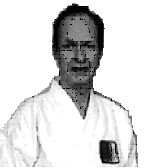 RICHARD STAMPER
RICHARD STAMPER
Mr. Stamper began his
training in martial arts in 1965. He
currently holds a Sichi Dan in Goju-Ryu
Karate, Yon Dan in Judo and Go Dan in Jujitsu. He also
has Kyoshi Certification and servers as the
Chairman Asistant for the GKK international.
He is a very knowledgeable and
experienced instructor.
Certifications:
-
Renshi: June 13, 1976
-
Kyoshi: January 15, 1983
-
**Karate -
-
Sho-dan: January 16, 1967 Shotokan; December 05,
1971 Goju-Kai
-
Ni-Dan: May 23, 1972 Goju-Kai
-
San-Dan: August 05, 1973 Goju-Kai
-
Yon-Dan: February 27, 1977
-
Go-Dan: March 6, 1980.
-
Roku-Dan: January 15, 1983 GKK
-
Shichi-Dan: January 14, 1995 GKK
-
**Judo -
-
Sho-Dan: June 20, 1972
-
Ni-Dan: July 15, 1974
-
San-Dan: December 20, 1995 USJA
-
Yon-Dan: October 9, 1997 USJA
-
**Jujitsu -
-
Sho-Dan: May 30, 1973
-
Ni-Dan: April 19, 1975
-
San-Dan: July 12, 1992
-
Yon-Dan: May 9, 1996 USJA
-
Go-Dan: March 12, 1997 USJA, GKK
|
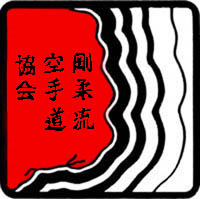 GOJU-RYU MASTERS
GOJU-RYU MASTERS RICHARD STAMPER
RICHARD STAMPER